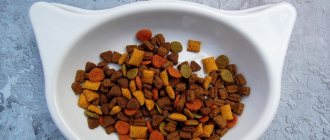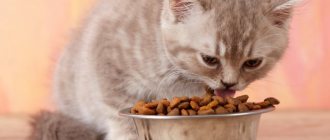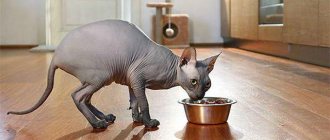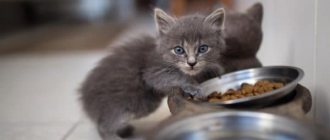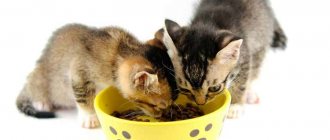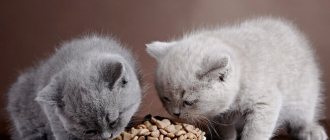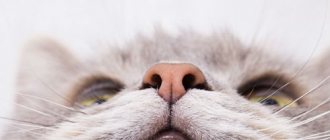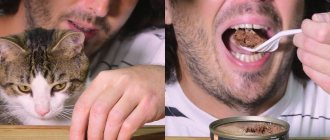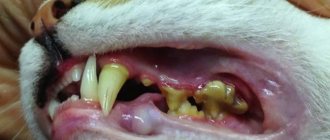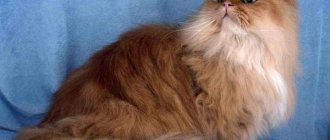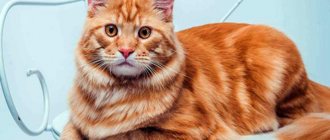The importance of water for a cat's body
The body of any living creature consists of cells. Any cell, in turn, consists of 80% liquid. Each specific cell of the body requires its own set of microelements, which can only enter it when dissolved in water. If a cat does not receive the required amount of water, this can lead to irreversible consequences - drying out, malnutrition, or even cell death. The amount of water your cat drinks is important for blood concentration. The less fluid you consume, the thicker your blood becomes. The heart has difficulty pumping thick blood; oxygen from the blood reaches muscles and tissues more slowly. The heart itself and the entire body as a whole, including the brain, suffer from this due to lack of oxygen. The health of the genitourinary system also depends on fluid intake. A small amount of water leads to a high concentration of salt in the urine, which causes the formation of urinary crystals. Concentrated urine causes urolithiasis in animals, which is very difficult and takes a long time to treat. Neutered cats are especially susceptible to urolithiasis, as they visit the toilet less often and are often less mobile.
The influence of diet composition on the drinking behavior of cats
Animal water consumption largely depends on the composition of the product and its moisture content. Cats that eat canned food practically do not drink water, since their need for liquid is met through food. The same applies to animals that are fed meat or fish.
Dry food contains only 7-8% moisture, and therefore cats that receive it need more water to meet their physiological needs. In addition, dry food was found to increase fecal water loss but reduce urinary water loss. Although cats' water intake varies greatly, their overall water balance is not affected by the moisture content of their diet. The formation of urinary stones is more determined by the mineral composition of urine and its pH than by the moisture content of the diet. The only situation in which the risk of developing urolithiasis increases is when animals are switched from canned food to dry food.
The calorie content of the diet does not have a significant effect on the level of water consumption. An increase in protein content in the diet, on the contrary, is associated with an increase in water consumption. Carbohydrates reduce your water intake due to greater water production during their metabolism. Sodium chloride increases thirst by inducing hypernatremia and thereby increases water intake in cats.
How much should a cat drink to be healthy?
Very often, cat owners are alarmed when their pets rarely approach the water bowl. Considering that the norm of fluid intake for a cat is from 30 to 40 ml per kg of live body weight, it is enough to weigh the pet to determine the required amount. But you need to take into account that a cat can partially obtain water from food. Especially if she is offered porridge with broth, kefir, milk and other natural products.
In this case, the cat will approach the bowl of water much less often than when feeding dry food. Dry food requires an increase in daily water intake by almost half.
For example, a cat weighing 4 kg should drink from 120 to 160 ml of water per day. But when feeding dry food, he can drink up to 180 or 240 ml. This will be quite normal.
For small kittens who are still close to their mother cat, it is normal to not want to drink water. After all, they can easily get the required amount of liquid per day from their mother’s milk. As the kitten grows, it will have to start drinking water when switching to “adult” food.
If it seems to you that your cat rarely comes to the water bowl and drinks insufficient amounts of water per day, analyze whether the pet can quench its thirst somewhere else. For example, many cats drink tap water with great pleasure. Cats also really like to drink water from large, tall containers. For example, from buckets, filled bowls, even from a filled bathtub. By nature, cats prefer, whenever possible, to choose rather wide and elevated drinking containers.
Sharing
Just because your cat doesn't drink much doesn't mean her body doesn't need it. The animal must be taught to drink enough water daily. And forget about drinking from the tap and cow's milk.
Why do cats drink noticeably less than dogs?
Evolutionarily modern domestic cats take their roots from wild ancestors who lived in the desert. There is no free access to water there; it is a shortage. Therefore, wild cats have adapted to consuming very small amounts of water, compared to, for example, dogs. This habit has been preserved in modern cats.
What are the consequences of lack of water for a cat?
Insufficient water consumption leads to the formation of very concentrated urine, which significantly increases the risk of developing diseases of the urinary system, namely the development of urolithiasis. Lack of water or consumption of poor quality water also entails consequences such as kidney diseases: renal failure, chronic kidney disease, impaired filtration function.
Is it okay to let your cat drink from the tap?
Cats should consume clean, fresh drinking demineralized water. Under no circumstances should cats be allowed to drink from the tap. This is untreated water and is not suitable for drinking. For animals, bottled water for babies is ideal.
How to make a cat drink?
In order for a cat to drink enough water, it is necessary to create conditions for this. The water bowl should not be too close to the food bowl - predators do not drink near food. The water bowl should be ceramic - not plastic or metal - and wide enough so that when drinking, the cat does not touch its edges with its sensitive whiskers - vibrissae. This is unpleasant for the cat, and he will not drink much under such conditions. The water should be fresh, clean, and at room temperature.
For those pets who prefer running water, it is recommended to purchase a special drinking fountain. They are not cheap, but they are simply irreplaceable for the health of cats.
What foods disrupt the water balance of the cat's body?
You should not feed cats food high in salt. For example, salted fish. This can lead to salt poisoning. On the other hand, many cat food manufacturers add a small amount of salt to their food to make the cat feel thirsty and consume more water.
How to calculate water requirement using formula?
When the question is urgent, and it is fundamentally important for the owner to know the daily rate of water consumption per day by his pet, then there is a simple formula for this: the weight of the cat in grams is multiplied by a coefficient of 0.03 V (ml) = m (g) * 0.03
According to this formula, a 3 kg cat needs approximately 100 ml of water per day. It should be noted that this includes all liquid that enters the body in any form: with milk, canned food, vegetables or other wet food. A kitten needs a little more water per 100 g of weight than an adult pet. On the other hand, a baby who is next to his mother may not drink at all, since his water needs are fully compensated by breast milk, which should also not be forgotten.
Polydipsia in cats
Any deviation from the norm for a cat's water consumption must be carefully studied. Her body begins to experience a sharp deficiency of fluid if she consumes less than 100 ml of water/kg of body weight during the day. Any cause of polyuria naturally leads to polydipsia.
Liver failure can also lead to the development of polydipsia due to decreased renin degradation and increased angiotensin activity.
The average level of water consumption by a cat depends on the amount of dry matter contained in the food it eats: a cat needs about 2 ml of water per 1 g of dry matter of food.
Based on the value of blood plasma osmolality, one can judge the nature of polydipsia:
- primary or compensatory.
- if the osmolality of blood plasma exceeds 310 mOsm/l, then polydipsia is classified as primary;
- if this indicator is below 290 mOsm/l, then the cause is considered to be loss of water in the urine.
Polydipsia can be a reaction to stress or the animal exhibiting increased activity as a result of constant anxiety.
How to provide a cat with water, which is so vital for it, in the required volume?
Many owners complain that their cat prefers a thin stream flowing from the tap to any source of water. This causes some inconvenience, because keeping the water flowing constantly is impractical, and constantly monitoring the cat and opening the water for it as soon as it shows a desire to do so is impossible. In order to solve the problem, it is necessary to understand the reasons for this behavior of the pet. The truth is that any animal will prefer running water to standing water, because it is the richest in oxygen - this is living water, the one that is needed for the health of the body. Cats instinctively feel this. Some of them like to drink from an aquarium, because the water there is either artificially enriched with oxygen, or oxygen is released by aquatic plants. In addition, the water is purified by filters and has a rich microelement composition resulting from the vital activity of fish and plants.
Thus, in order for the cat to drink enough liquid, it needs to have fresh water at its disposal at all times. How to achieve this? The simplest thing is to put a bowl of the largest, literally “dog” size. The larger the volume of liquid, the longer oxygen remains in it. You can pour water from the tap if you are sure of its quality. If not, filters must be used, but not all animals drink filtered water. Most filters purify water from chlorine and other substances that are used to disinfect it, but while removing harmful things, the filter also removes useful things - salts and microelements. Like boiled water, this water becomes “dead” and therefore unattractive to the cat. The solution may be bottled water, but not just purified water (such as Bon Aqua), but water enriched with microelements (such as Arkhyz, Novoterskaya, etc.) You need to change the water in the bowl as often as possible: several times a day, regardless of whether whether the cat drank or not, because oxygen leaves stagnant water very quickly.
Special devices
To organize a source of “living water” for your cat, you should take advantage of the offers of pet supply manufacturers.
Knowing the problem with drinking in cats, they have long been producing so-called fountain drinkers. All drinking fountains are designed approximately the same, the difference is in shapes, sizes, volumes of liquid, etc. Using an electric pump, water is constantly pumped through a filter that traps wool, dust and other large fractions, and also cleans it of bacteria. Thanks to constant circulation, the liquid is enriched with oxygen, and it needs to be topped up only as natural evaporation occurs - approximately once a week. Depending on the model, a stream of water can simply flow freely from a height, or it can shoot out from the bottom of the drinker, forming an ordinary fountain. In some drinking bowls, this fountain is covered with a dome with a hole at the top, through which water flows freely, constantly forming a thin film on the surface of the dome - cats happily lick it off. This drinking bowl is ideal for long-haired animals, as it does not create splashes at all and allows them to drink without getting their faces wet.
The cost of electric drinkers, of course, is much higher than a regular ceramic bowl - from 2 to 5 thousand rubles. But a device from a good manufacturer will last a long time, and consumes very little electricity - from 2 to 4 W, depending on the size and, accordingly, the volume of the pumped liquid. The only thing you have to regularly spend money on is replacement carbon filters, but in principle you can look at a model without filters at all. In any case, it seems to me that the cat’s health is worth these generally small costs.
Feeding regimen and norm
The owner must know how many times the kitten needs to be fed in order to properly create a diet for it. A growing cat gradually needs to increase the portion size, reducing the number of feedings.
- A two-month-old kitten should be fed 6 times a day. The daily food intake is 180-200g.
- A 3 month old kitten is fed 5 times a day. The norm is 200-250g.
- At 4-5 months, the kitten is fed 4 times a day. The norm is 250g.
- A six-month-old kitten is given three meals a day. The norm is 250-300g.
Is all water healthy?
When deciding how much a cat should drink, you should choose water that will benefit your pet.
- Boiled water is dead water, according to scientists. It brings less benefits, and after storage for three hours it even becomes harmful. Many veterinarians believe that drinking boiled water can lead to the development of urolithiasis. Owners with the best intentions quite often try to give their pets this kind of water - sometimes this is the reason why the cat does not drink water. By the way, boiled water changes its properties, turning into a “magnet” for bacteria, viruses and other microorganisms contained in the environment.
- Distilled water is lifeless and useless. It is obtained by boiling - the steam is collected and cooled. All microelements remain “overboard”, and they are vitally necessary for the body. In addition, distilled water almost does not conduct current, and the absence of electromagnetic pulses in moisture leads to a slowdown in the movement of moisture in the body.
- Fresh tap water often contains too many heavy salts, metals, chloride compounds and other “nasties” that are absolutely unnecessary for the cat’s body. Sometimes a cat drinks little because of an unpleasant odor or taste that owners do not notice due to prolonged use of tap water.
- Bottled water is a good option if you can find a quality product. Often, Russian manufacturers (which is officially permitted) sell ordinary tap water, industrially purified and enriched with minerals (an excess of which can lead to the occurrence of ICD), under the guise of “natural” water of the first category.
You should choose water of the highest category, marked “drinking”, obtained from underground sources (the well number, chemical composition and place of production must be indicated on the label). So what kind of water should you give? There are two options: filtered or settled tap water. The water needs to stand in the refrigerator, in a tightly closed glass jug, for six to eight hours.
When should you drink water?
The basic and immutable rule is that you need to start drinking long before you want to. You only need to take food when you are hungry, so as not to gain weight.
When exactly you need to drink is an individual matter. Doctors did not invent any special rules in this regard. Someone can drink at a strictly defined time. And some - chaotically. Any time a bottle of water or a juice box appears in front of your eyes. By the way, in order not to forget about drinking, bottles and bags can be placed in the most visible places so that they are more often noticeable.
Weight control
For most breeds, the first year of life is the most active, and it is during this time that the kitten grows rapidly and gains weight. If the pet receives sufficient nutrition, all its indicators will be normal.
It is advisable to monitor the weight of a cat at 2 months every week, writing down all the data in a notebook (this will be very helpful in case the gain is insufficient and you have to contact a veterinarian).
If a kitten eats enough at 2 months, its weight should be in the range of 400-900 g (the average is approximately 600 g). But for some breeds, these data may be different: some representatives of large breeds by this age gain weight from 1 to 1.5 kg (for example, Maine Coon, British and Scottish kittens).
